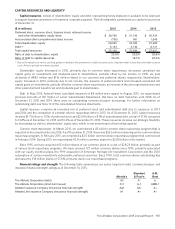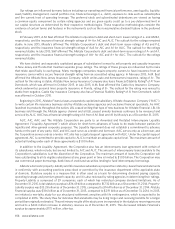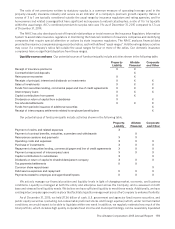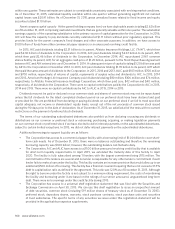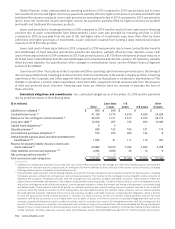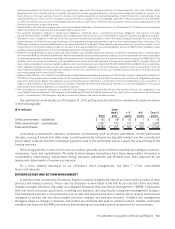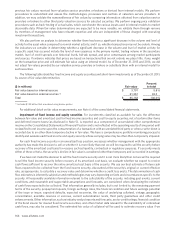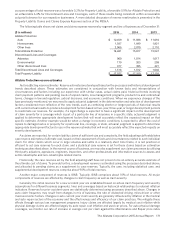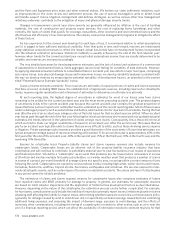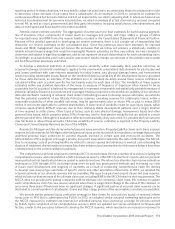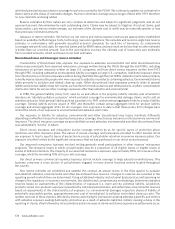Allstate 2015 Annual Report Download - page 172
Download and view the complete annual report
Please find page 172 of the 2015 Allstate annual report below. You can navigate through the pages in the report by either clicking on the pages listed below, or by using the keyword search tool below to find specific information within the annual report.
166 www.allstate.com
previous fair values received from valuation service providers or brokers or derived from internal models. We perform
procedures to understand and assess the methodologies, processes and controls of valuation service providers. In
addition, we may validate the reasonableness of fair values by comparing information obtained from valuation service
providers or brokers to other third party valuation sources for selected securities. We perform ongoing price validation
procedures such as back-testing of actual sales, which corroborate the various inputs used in internal models to market
observable data. When fair value determinations are expected to be more variable, we validate them through reviews
by members of management who have relevant expertise and who are independent of those charged with executing
investment transactions.
We also perform an analysis to determine whether there has been a significant decrease in the volume and level of
activity for the asset when compared to normal market activity, and if so, whether transactions may not be orderly. Among
the indicators we consider in determining whether a significant decrease in the volume and level of market activity for
a specific asset has occurred include the level of new issuances in the primary market, trading volume in the secondary
market, level of credit spreads over historical levels, bid-ask spread, and price consensuses among market participants
and sources. If evidence indicates that prices are based on transactions that are not orderly, we place little, if any, weight
on the transaction price and will estimate fair value using an internal model. As of December 31, 2015 and 2014, we did
not adjust fair values provided by our valuation service providers or brokers or substitute them with an internal model for
such securities.
The following table identifies fixed income and equity securities and short-term investments as of December 31, 2015
by source of fair value determination.
($ in millions) Fair value
Percent
to total
Fair value based on internal sources $ 3,791 5.8%
Fair value based on external sources (1) 61,361 94.2
Total $ 65,152 100.0%
(1) Includes $1.32 billion that are valued using broker quotes.
For additional detail on fair value measurements, see Note 6 of the consolidated financial statements.
Impairment of fixed income and equity securities For investments classified as available for sale, the difference
between fair value and amortized cost for fixed income securities and cost for equity securities, net of certain other items
and deferred income taxes (as disclosed in Note 5), is reported as a component of accumulated other comprehensive
income on the Consolidated Statements of Financial Position and is not reflected in the operating results of any period until
reclassified to net income upon the consummation of a transaction with an unrelated third party or when a write-down is
recorded due to an other-than-temporary decline in fair value. We have a comprehensive portfolio monitoring process to
identify and evaluate each fixed income and equity security whose carrying value may be other-than-temporarily impaired.
For each fixed income security in an unrealized loss position, we assess whether management with the appropriate
authority has made the decision to sell or whether it is more likely than not we will be required to sell the security before
recovery of the amortized cost basis for reasons such as liquidity, contractual or regulatory purposes. If a security meets
either of these criteria, the security’s decline in fair value is considered other than temporary and is recorded in earnings.
If we have not made the decision to sell the fixed income security and it is not more likely than not we will be required
to sell the fixed income security before recovery of its amortized cost basis, we evaluate whether we expect to receive
cash flows sufficient to recover the entire amortized cost basis of the security. We use our best estimate of future cash
flows expected to be collected from the fixed income security, discounted at the security’s original or current effective
rate, as appropriate, to calculate a recovery value and determine whether a credit loss exists. The determination of cash
flow estimates is inherently subjective and methodologies may vary depending on facts and circumstances specific to the
security. All reasonably available information relevant to the collectability of the security, including past events, current
conditions, and reasonable and supportable assumptions and forecasts, are considered when developing the estimate
of cash flows expected to be collected. That information generally includes, but is not limited to, the remaining payment
terms of the security, prepayment speeds, foreign exchange rates, the financial condition and future earnings potential
of the issue or issuer, expected defaults, expected recoveries, the value of underlying collateral, vintage, geographic
concentration, available reserves or escrows, current subordination levels, third party guarantees and other credit
enhancements. Other information, such as industry analyst reports and forecasts, sector credit ratings, financial condition
of the bond insurer for insured fixed income securities, and other market data relevant to the realizability of contractual
cash flows, may also be considered. The estimated fair value of collateral will be used to estimate recovery value if we



